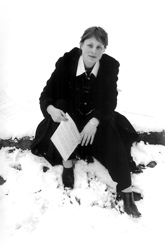|

photo:
Romualdas Rakauskas |
The music of
Zita Bružaitė (b. 1966) is so manifold and varied that it seems as if the composer is consciously changing her style with every new composition, from philosophical eloquence to light-hearted tricks in the vein of medieval minstrels. Skilfully manipulating the possibilities of diversity of styles, techniques and idioms provided by postmodernist aesthetics, Bružaitė blends medieval asceticism with modernist flamboyance, folk intonations with jazz improvisations. The search for a direct emotional contact with the audience, and ability to render complex technological processes in a playful and attractive manner - this is what makes her music appealing. The composer claims that each of her works is a self-contained entity: it is always a new turn towards different vital flow of sounds. "My music, like that by many of my contemporaries, does not have any general, uniform system, it does not follow any rigorous rules or mind anybody's opinions." On the other hand, the composer distinguishes two different, opposing trends in her work.
The first one is represented by the works of conceptual nature and hardly definable genre, with no lack of theatrical elements, such as the 'musical rebus' written in her study years,
Toeliali for voices and three timbral lines (1991). Here the dadaistic poetry by Pranas Morkūnas, representative of Lithuanian avant-garde of the 1930s, is dispersed throughout the freely notated fretwork of lines of acoustic instruments (clarinet and cello), voice (soprano) and electronics. This trend is further reflected in the more recent compositions, such as
Pilgrims, concerto-poem for saxophone and bassoon choir (1999) inspired by tragic events in Kosovo,
Blues Mania for trumpet, jazz singer and double wind quintet (2000), and
Fugue for singing voice, speaking voice, piano and electronics (2003) that was premiered during the
Pažaislis Festival this summer in Kaunas.
Another large group consists of compositions written in a more moderate idiom and scored for different settings, revealing the broad spectrum of 20th-century styles and technologies - from aspects of serialism to numerical combinatorics, chance-composed rhythms and 'collage' technique. Zita Bružaitė is one of the most prolific and successful Lithuanian authors in this field, managing to combine the tradition of concert genres with the fresh eloquence, at the same time also leaving room for performers to demonstrate their skills. Her latest work,
Fading Dance, written on commission from the Gaida Festival for the legendary Dutch wind band
De Volharding, is supposed to oppose the mainstream of concert music harboured at contemporary music festivals. According to the author, during the process of composition, she kept the modernity concerns in the background and 'slipped down' from complex structures and deep meanings to light irony and fun. This 'slip', unexpectedly, determined the choice of the title and structural solutions, with sudden detours to polyrhythmic, hocketing interludes running into the monotony of minimalist rhythms. The virtuoso quality was encouraged by the extraordinary potential of Dutch wind players who will premiere this piece on October 12 at the Lithuanian National Philharmonic.
The line of concert music is continued by several new compositions by Zita Bružaitė which await their premiere performances at the "Iš arti" festival in Kaunas in November.
Sonnet II "Rain Loves Me" for soprano, piano and string quartet is the second part of the sonnet cycle that was conceived during her residency at the
Visby International Centre for Composers.
Sonnet II ventures the fusion of art and pop music worlds represented by bel canto and jazz. These days, the composer is found putting finishing touches to her second symphonic poem
Laterna Magica based on the allusions to the compositional games of
Guido d'Arezzo. In this work, which will appear as the second part (after
Ignis fatuus, 1994) of the symphonic diptych, the author once again turns back to the Middle Ages, the inexhaustible source of her creative discoveries and inspiration.
© Dainora Merčaitytė
Lithuanian Music Link No. 7

